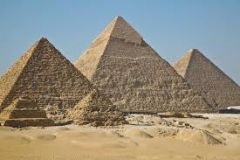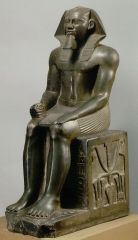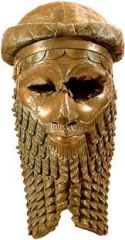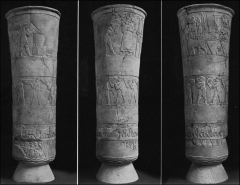![]()
![]()
![]()
Use LEFT and RIGHT arrow keys to navigate between flashcards;
Use UP and DOWN arrow keys to flip the card;
H to show hint;
A reads text to speech;
5 Cards in this Set
- Front
- Back

|
Men taunting a deer-6,000 BCE-Neolithic -Catalhoyuk, Konya plain of central Turkey-lime-first traces of a settlement in Catalhoyuk. Narratives/scenes painted on walls of the settlement. Art depicts dangerous interactions btw humans and animals. Here huge deer is surrounded by humans. Emphasis on maleness: some of the figures are bearded and the deer has an erect penis. -Catalhoyuk-houses made of mud bricks, no streets, narrative art starts to evolve |
|

|
Date: 2500 BCE, Old Kingdom EgyptianArtist: unknownPatron: Menkaure, Khafre, and KhufuLocation: Giza, EgyptMaterial: limestoneTechnique: architectureFunction: used in celebration of the dead pharaohs to honor their Ka to find a new life, home for the dead, symbols of the sun, used by pharaohs to ascendContext: oriented to the four points of the compass, capped with pyramidion, Khufus is the largestDetails: large, cultural evolution, symbolic, ceremonial with detailsIdeas: cultural evolution, ceremonial |
|

|
Seated Ka Statue of KhafreDate: 2500 BCEPeriod/Style: Old Kingdom EgyptianArtist: unknownPatron: KhafreLocation: Giza, EgyptMaterial: dioriteTechnique: sculpture - subtractive method of sculptingFunction: perfect sculpture with ideal proportions, flawless because Khafre is a pharaoh/god, represents who Khafre was, Horus the falcon stands behind Khafre's head to represent protection, lions on his chair (kings of kings)Context: subtractive method of sculpting, no negative space to prevent from breaking ,symbol of pharaoh's connection with the godDetails: frontal, perfect, symmetrical, rigid, idealized, calm, greatnessIdeas: perfection seen in sculpture |
|

|
Head of an Akkadian ruler - ca. 2300 B.C. - Akkadian - Earliest major work of hollow-cast copper sculpture known in Ancient Near East; facial features of a generalized ideal male appearance (beard and braided hair) - Bronze |
|

|
Warka VaseDate: 3200 BCE -Sumerian - Material/Technique: registers(separate compartments); bottom register alternates male and female; shows agriculture and fertility; creates a festival and offerings; twisted perspective eyeballs; top register is the king/heirarchal figureFunction: to tell a narrative of a religious festival in honor of a goddessContext: Sumerians were one of the first to use art to tell stories; Vase is from Uruk, modern WarkaIdeas: The depiction of the people is conceptual because their eyes are emphasized in oval shapes. Also, it is believed that the vase is a depiction of a marriage between a priest-king and a goddess. |

